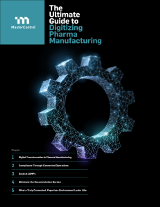
GxP Lifeline
Integration Is the Fast Lane to Data

The first time I heard the term iPaaS (integration platform as a service), I immediately thought of I-PASS. I-PASS is the electronic toll collection system used in Illinois. If you want to get anywhere in Chicago or the surrounding suburbs, odds are you’ll wind up paying a toll. Few things are more annoying than zooming along on the highway, only to have to screech to a halt to throw a few coins out the window. This scenario is largely a thing of the past thanks to devices such as the I-PASS. Now you only have to slow down slightly to get through a toll and the biggest problem with the system is the fact that you’re still paying to drive.
What I-PASS does for driving on a tollway, iPaaS does for dealing with disparate software solutions. Instead of slowing down your processes while you manually deal with issues, it speedily brings data together. You’ve heard us extol the virtues of a platform approach. While this is ideal, we recognize that no software provider has every type of software that a company might need. And even if they did you might find it simpler to integrate the solutions rather than switch everything over to a new provider. There are major advantages to integrating your solutions, most of which have to do with data.
Data Integrity
Data integrity is a big deal in the life sciences. Regulators have guidelines for data integrity, but companies repeatedly fall short. In 2016, 43% of the warning letters issued by the U.S. Food and Drug Administration (FDA) were due to data integrity issues.1 Most of these violations were due to data not being fully and accurately documented. Integrated solutions go a long way toward solving this problem. Pulling data from one application into another prevents the human error that comes from manually re-entering data. For example, an iPaaS solution pulls information from an enterprise resource planning (ERP) system into a manufacturing execution system (MES).
Data Consolidation
Related to the idea of having complete data is having consolidated data. Complete data that isn’t consolidated isn’t much use. If a company has three manufacturing lines and complete data on all three, that’s good. But unless it can be consolidated, it isn’t much use. Complete data about a manufacturing line can give you insights into that line, but taking a look at the manufacturing process as a whole is much more complicated without integrations. Bringing all of a company’s data together is where iPaaS excels. Trying to bring it together without iPaaS involves a lot of manual work with no guarantee that all the data is being used.
Data-Driven Decisions
Life sciences companies provide life-saving products and services. Logically, they should use the most cutting-edge technology to ensure that their products save or improve lives as intended. Any decision about those products, services or the business should not just be left up to experience or estimate. Integrating systems brings together data in such a way that advanced analytics can be used to inform decision-making. One example of this comes from a hospital in France that uses “big data and machine-learning tools to predict admission rates, leading to a more efficient allocation of resources — in staffing among others — and improved patient outcomes.”2 iPaaS helps companies make decisions in every area of the business because it brings together information from every area of the business.
Conclusion
If you feel like you’re reading about big data everywhere, it’s because it has the potential to make such a large impact on every industry and every business. But that potential can only be realized if data integrity is ensured, the data is consolidated, and the data is analyzed in such a way that it can drive decision-making. There are ways to do this without integrated systems. Those ways involve copying/pasting and retyping information. This can work, assuming the person doing the job never makes mistakes and always uses up-to-date sources. Even in ideal conditions, this manner of data consolidation is like slamming on the brakes when it comes to analytics.
The analytics fast lane is only accessible through iPaaS. For our customers, this lets their MasterControl solutions exchange information with the other software solutions they use. For example, MasterControl Customer Complaints can exchange data with an ERP. If that complaint is tracked in a customer relationship management (CRM) solution, it can export data to MasterControl Quality Excellence to improve product quality. Seamless integration between solutions is what guarantees data integrity and smarter decision-making in the future.
Sources
- Deloitte. “Data integrity in the life sciences.” Retrieved from https://www2.deloitte.com/bm/en/pages/life-sciences-and-healthcare/articles/data-integrity-life-sciences.html
- PwC. “Advanced analytics fuel tomorrow’s commercial strategy for drugs and devices.” March 2019. Retrieved from https://www.pwc.com/us/en/health-research-institute/assets/pwc-pls-advanced-analytics-report.pdf

